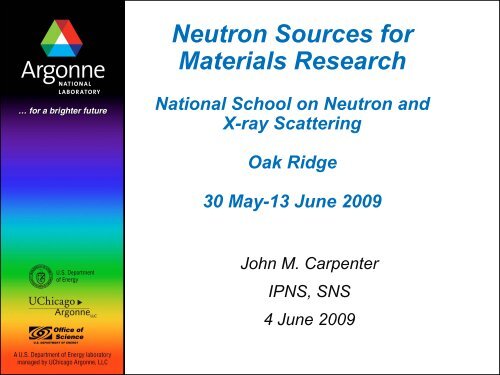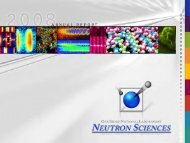Argonne PowerPoint Presentation - Spallation Neutron Source
Argonne PowerPoint Presentation - Spallation Neutron Source
Argonne PowerPoint Presentation - Spallation Neutron Source
Create successful ePaper yourself
Turn your PDF publications into a flip-book with our unique Google optimized e-Paper software.
<strong>Neutron</strong> <strong>Source</strong>s for<br />
Materials Research<br />
National School on <strong>Neutron</strong> and<br />
X-ray Scattering<br />
Oak Ridge<br />
30 May-13 June 2009<br />
John M. Carpenter<br />
IPNS, SNS<br />
4 June 2009
<strong>Neutron</strong>s and <strong>Neutron</strong> <strong>Source</strong>s<br />
James Chadwick discovered the neutron in 1932.<br />
In 1936 Mitchel & Powers and Halban & Preiswerk first demonstrated coherent<br />
neutron diffraction in (Bragg scattering by crystal lattice planes) as an exercise<br />
in wave mechanics.<br />
The possibility of using the scattering of neutrons as a probe of materials<br />
developed after 1945 with the availability of copious quantities of slow neutrons<br />
from reactors. Fermi's group used Bragg scattering to measure nuclear crosssections<br />
at early <strong>Argonne</strong> reactors.<br />
The neutron is a weakly interacting, non-perturbing probe with simple, wellunderstood<br />
coupling to atoms and spins.<br />
The scattering experiment tells you about the sample not the probe.<br />
98-6245 uc/vlb<br />
2
<strong>Neutron</strong>s and <strong>Neutron</strong> <strong>Source</strong>s-cont’d<br />
A reactor moderates the neutrons produced in the fission chain reaction<br />
resulting in a Maxwellian energy distribution peaked at T (300K).<br />
“Thermal” neutrons:<br />
98-6243 uc/rfg<br />
3
Development of <strong>Neutron</strong> Science Facilities<br />
Redrawn 2009<br />
97-3924E uc/djr<br />
4
How do we produce neutrons?<br />
Fission<br />
Chain reaction<br />
Continuous flow<br />
~ 1 neutron/fission<br />
<strong>Spallation</strong><br />
No chain reaction<br />
Accelerator driven<br />
Pulsed operation<br />
~ 30 neutrons/proton<br />
5
<strong>Neutron</strong>s: Where do they come from?<br />
Fission:<br />
n + 235 U = n + n + fragments<br />
Sustain chain reaction<br />
Moderated by<br />
D 2O (H 2O)<br />
Available<br />
to E ~ k BT (Maxwellian)<br />
~ 180 MeV/n (as heat)<br />
98-6239 uc/vlb<br />
6
<strong>Neutron</strong>s: Where do they come from?<br />
<strong>Spallation</strong>:<br />
p + heavy nucleus = 20 ~ 30 n + fragments<br />
1GeV e.g. W, Pb, U<br />
Compare Fluxes<br />
Reactors<br />
DR3 Risø 2 x 1014 n/cm2 /s<br />
ILL Grenoble 1.5 x 1015 n/cm2 ~ 30 MeV/n (as heat)<br />
/s<br />
<strong>Spallation</strong> sources<br />
ISIS @ 160 kW average 1.2 x 10 13 n/cm 2 /s<br />
peak 6 x 10 15 n/cm 2 /s<br />
SNS @ 2 MW average 4 x 10 13 n/cm 2 /s<br />
peak 3 x 10 16 n/cm 2 /s<br />
98-6240 uc/vlb<br />
7
<strong>Neutron</strong>s: Where do they come from?<br />
Measured <strong>Spallation</strong> <strong>Neutron</strong> Yield vs. Proton Energy for<br />
Various Targets, J. Frazer, et al. (1965)<br />
Absolute Global<br />
<strong>Neutron</strong> Yield<br />
Yield (neutrons/proton)<br />
= 0.1(E GeV - 0.12)(A+20),<br />
except fissionable materials;<br />
= 50.(E GeV - 0.12), 238 U.<br />
From Fraser et al., measurements at Brookhaven Cosmotron<br />
2000-05264 uc/arb<br />
8
<strong>Neutron</strong>s: Where do they come from?<br />
Low-energy (p,n) reactions, e.g.<br />
p + 9Be —> n + 2αλπηα + π ανδ<br />
> ν + 9Β (Most of the proton energy appears as heat.)<br />
5-15 MeV ~ 1300 MeV/n @ Ep = 13 MeV<br />
(deposited in ~ 1.1 mm)<br />
3.5x10-3 n/p<br />
Fluxes at moderator surface<br />
LENS @ 30 kW time average 4 X 10 11 n/cm 2 -sec<br />
@ 20Hz peak 1 X 10 14 n/cm 2 -sec<br />
Global neutron yield for Be (p,n)<br />
Y = 3.42x10 8 (E MeV - 1.87) 2.05 n/μιχροC<br />
98-6240 uc/vlb<br />
9
Types of <strong>Neutron</strong> <strong>Source</strong>s-cont’d<br />
Reactor e.g., HFR at ILL, Grenoble, France.<br />
~1.5x10 15 n/cm 2 /s (recently underwent major refurbishment)<br />
Advantages<br />
– High time averaged flux.<br />
– Mature technology (source + instruments).<br />
– Very good for cold neutrons.<br />
Drawbacks<br />
– Licensing (cost/politics).<br />
– No time structure.<br />
98-6237 uc/rra<br />
10
Types of <strong>Neutron</strong> <strong>Source</strong>s<br />
The Institut Laue-Langevin, Grenoble<br />
2000-05269 uc/arb<br />
11
Types of <strong>Neutron</strong> <strong>Source</strong>s-cont’d<br />
<strong>Source</strong> Spectra of the FRM-II Reactor<br />
neutron<br />
flux,<br />
n/cm 2 -sec<br />
wavelength, Å<br />
98-6245 uc/vlb<br />
12
Types of <strong>Neutron</strong> <strong>Source</strong>s-cont’d<br />
Low-Energy <strong>Neutron</strong> <strong>Source</strong>s<br />
Advantages of a Low-Energy <strong>Neutron</strong> <strong>Source</strong>.<br />
– Low cost of accelerator.<br />
– Low cost of operation.<br />
– Minimal shielding because of low proton energy.<br />
– Cold moderators easy.<br />
– Easily adaptable for testing, development and training.<br />
– Modest flux implies low activation of components.<br />
Disadvantages of a low-energy neutron source.<br />
– Modest flux implies long experiment times.<br />
– Optimal design provides only three neutron beams.<br />
98-6240 uc/vlb<br />
13
Types of <strong>Neutron</strong> <strong>Source</strong>s-cont’d<br />
The LENS Low-Energy <strong>Neutron</strong> <strong>Source</strong>, Indiana U.<br />
protons<br />
98-6240 uc/vlb<br />
14
How Do Moderators Work?<br />
Steady sources<br />
98-6240 uc/vlb<br />
15
How Do Moderators Work?<br />
Steady sources<br />
Cavity-type cold source Hot source<br />
98-6240 uc/vlb<br />
16
How Do Moderators Work?<br />
Pulsed sources<br />
Decoupled, reflected<br />
pulsed-source moderator<br />
98-6240 uc/vlb<br />
17
Types of <strong>Neutron</strong> <strong>Source</strong>s-cont’d<br />
Pulsed spallation sources e.g., IPNS, ISIS, LANSCE, SNS.<br />
200 µA, 0.8 GeV, 160 kW 1.4 mA, 1.0 GeV, 1.4 MW<br />
ISIS 2x10 13 n/cm 2 /s average flux SNS<br />
8x10 15 n/cm 2 /s peak flux<br />
Advantages<br />
– High peak flux.<br />
– Advantageous time structure for many applications.<br />
– Accelerator based – politics simpler than reactors.<br />
– Technology rapidly evolving.<br />
Disadvantages<br />
– Low time averaged flux.<br />
– Not all applications exploit time structure.<br />
– Rapidly evolving technology.<br />
98-6235 uc/rra<br />
18
<strong>Spallation</strong>-Evaporation<br />
Production of <strong>Neutron</strong>s<br />
Original<br />
Nucleus<br />
Excited<br />
Nucleus<br />
Residual<br />
Radioactive<br />
Nucleus<br />
Ep<br />
Proton<br />
~10 –20 sec<br />
> 1 sec<br />
~<br />
‘<br />
‘<br />
‘<br />
e<br />
γ<br />
‘<br />
‘<br />
‘<br />
‘<br />
‘<br />
γ<br />
Recoiling particles<br />
remaining in nucleus<br />
‘<br />
‘<br />
e<br />
‘<br />
γ<br />
Emerging “Cascade” Particles<br />
(high energy, ~ E < Ep) (n, p. π, …)<br />
(These may collide with other<br />
nuclei with effects similar to<br />
that of the original proton<br />
collision.)<br />
Evaporating Particles<br />
(Low energy, E ~ 1–10 MeV);<br />
(n, p, d, t, … (mostly n)<br />
and γ rays and electrons.)<br />
Electrons (usually e + )<br />
and gamma rays due to<br />
radioactive decay.<br />
19
Types of <strong>Neutron</strong> <strong>Source</strong>s-cont’d<br />
CW spallation source e.g., SINQ at Paul Scherrer Institut (PSI).<br />
Advantages<br />
0.85 mA, 590 MeV, 0.9 MW<br />
1x1014 n/cm2 /s average flux<br />
– High time averaged flux.<br />
– Uses reactor type instrumentation (mature technology).<br />
– Politically acceptable.<br />
– piggy-backed on existing accelerator.<br />
Disadvantages<br />
– No time structure.<br />
– high background feared but not realized.<br />
98-6236 uc/rra<br />
20
Types of <strong>Neutron</strong> <strong>Source</strong>s-cont’d<br />
Principles of the <strong>Spallation</strong> <strong>Neutron</strong> <strong>Source</strong> SINQ<br />
2000-05271 uc/arb<br />
21
Some History:<br />
The Materials Testing Accelerator<br />
E. O. Lawrence conceived this project in the late 1940s as a means to<br />
produce Pu-239 and tritium and, later, U-233. Despite its name, MTA<br />
was never intended for materials research.<br />
Work went on at the site of the present Lawrence Livermore<br />
Laboratory, where scientists accomplished substantial high-power<br />
accelerator developments. Efforts continued until 1955 when intense<br />
exploration efforts revealed large uranium ore reserves in the U.S. and<br />
the project terminated. By that time the pre-accelerator had delivered<br />
CW proton currents of 100 mA and 30 mA of deuterons. The work was<br />
declassified in 1957.<br />
2000-05265 uc/arb<br />
22
History<br />
The Materials Testing Accelerator:<br />
Machine Parameters<br />
There was already by that time some information on the production of<br />
spallation neutrons by 190-MeV deuteron-induced spallation on<br />
Uranium, about 30% more than by protons of the same energy. This<br />
guided the choice of accelerated particle type and beam energy. With<br />
the anticipated required production rate, the parameters of the<br />
accelerator were set:<br />
– Deuterons.<br />
– Particle energy – 500 MeV.<br />
– CW operation – 320 mA (beam power 160 MW).<br />
2000-05266 uc/arb<br />
23
The Materials Testing Accelerator: Target<br />
Original ideas concerned a Uranium target.<br />
Subsequent development led to target systems alternatives<br />
including moderated subcritical lattices (k < 0.9).<br />
Finally the chosen target system consisted of a NaK-cooled<br />
Beryllium primary target, and depleted Uranium secondary target<br />
for neutron multiplication, within a water-cooled depleted Uranium<br />
lattice for breeding Plutonium.<br />
2000-05267 uc/arb<br />
24
MTA-cont’d<br />
Cutaway View of Linear Accelerator – Looking from the Injector<br />
End<br />
2000-05268 uc/arb<br />
25
Earliest Pulsed <strong>Spallation</strong> <strong>Neutron</strong> <strong>Source</strong>s<br />
Facility<br />
Location<br />
Time-Average<br />
Beam Power<br />
(kW)<br />
Proton<br />
Energy<br />
(MeV)<br />
Pulsing<br />
Freque ncy<br />
(Hz)<br />
Startup Date/Status<br />
ZING-P <strong>Argonne</strong> 0.1 300 30 1974-75/Shutdown<br />
ZING-P’ <strong>Argonne</strong> 3 500 30 1977-80/Shutdown<br />
KENS KEK, Japan 3.5 500 20 1980-2006/Shutdown<br />
IPNS <strong>Argonne</strong> 7.0 450 30 1981/Operating<br />
ISIS Rutherford -<br />
160 800 50 1985/Operating<br />
MLNSC<br />
(Lujan<br />
Center)<br />
Appleton La b, UK<br />
Los Alamos 60 (upgrade<br />
underway t o<br />
160 kW)<br />
Primary source pulse widths of all are less than 0.5 µsec<br />
800 20<br />
(upgrade<br />
30 Hz?)<br />
1985/Operating<br />
2000-05277 uc/arb<br />
26
Pulsed <strong>Spallation</strong> <strong>Neutron</strong> <strong>Source</strong><br />
Construction, Proposals, and Studies<br />
Proton Beam Power<br />
(MW)<br />
Proton<br />
Energy<br />
Pulsing<br />
Frequency<br />
Name Location<br />
Status<br />
(GeV) (Hz)<br />
IPNS <strong>Argonne</strong> 1.0 2.0 30 Study complete –<br />
Upgrade<br />
terminated<br />
SNS Oak Ridge 2.0 1.0 60 Complete June<br />
2006<br />
AUSTRON Austria 0.2 (includes 1.6 25 Study complete –<br />
upgrades for beam<br />
(upgrade Approval pending<br />
power up to 1 MW)<br />
50 Hz)<br />
ESS Europe 5.0 1.33 50 Ongoing study<br />
JSNS JAEA, 0.6 (potential for 3.0 25 Under Construction<br />
Tokai-mura, upgrades to 5 MW)<br />
(upgrade to First operation<br />
Japan<br />
50 Hz)<br />
2008<br />
LPSS Los Alamos 1.0 MW 0.8 60 Ongoing study<br />
CSNS Dongguan, 100 kW (potential for 1.6 25 Near commitment<br />
China upgrade to ~1 MW)<br />
2000-05278 uc/arb<br />
27
Anatomy of a Pulsed <strong>Spallation</strong> <strong>Neutron</strong> <strong>Source</strong><br />
97-3792B uc/djr<br />
28
The <strong>Spallation</strong> <strong>Neutron</strong> <strong>Source</strong><br />
The SNS construction project concluded in 2006, shown in spring 2007.<br />
First operation April 2006, 800 kW in June 2009.<br />
At 1.4 MW it will be ~ 8x ISIS, the world’s leading pulsed spallation source.<br />
The peak neutron flux will be ~ 20 to 100 x ILL.<br />
SNS will be the world’s leading facility for neutron scattering.<br />
It is a short distance from HFIR, a reactor with a flux comparable to ILL.<br />
29
SNS Target-Moderator-Reflector System<br />
98-6245 uc/vlb<br />
30
SNS Moderator Intensities and Pulse Widths<br />
Results for 2 MW beam power, 60 Hz pulsing frequency—2.08 x 10 14 protons/pulse at 1. GeV.<br />
98-6245 uc/vlb<br />
31
SNS Instruments<br />
~20 instruments approved.<br />
– Excellent progress with funding.<br />
• DOE, including SING1 and SING2 Projects, foreign, and NSF<br />
initiatives<br />
Working to enhance instrument technology<br />
• International<br />
engagement and<br />
interest in the<br />
instrument suite.<br />
• Continuing<br />
engagement with<br />
scientific community.<br />
32
End of <strong>Presentation</strong><br />
Thank you!<br />
33
















